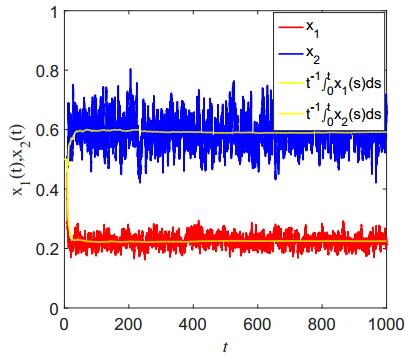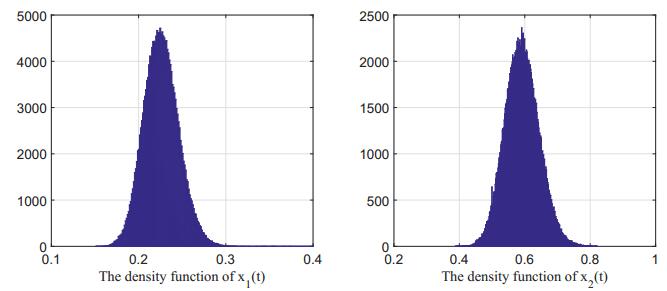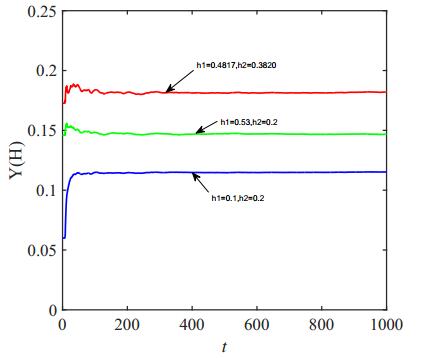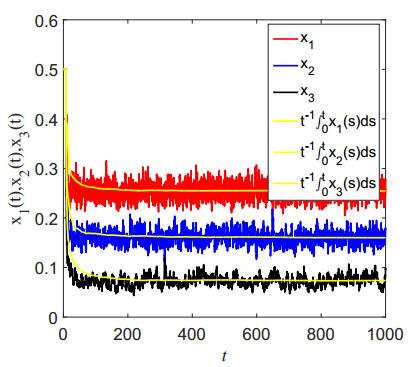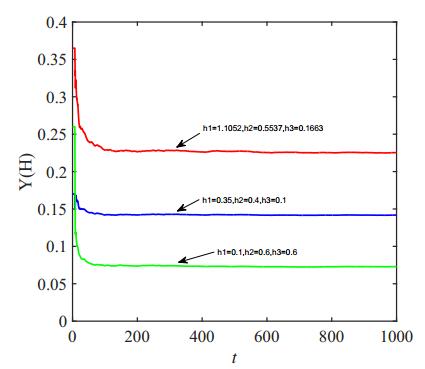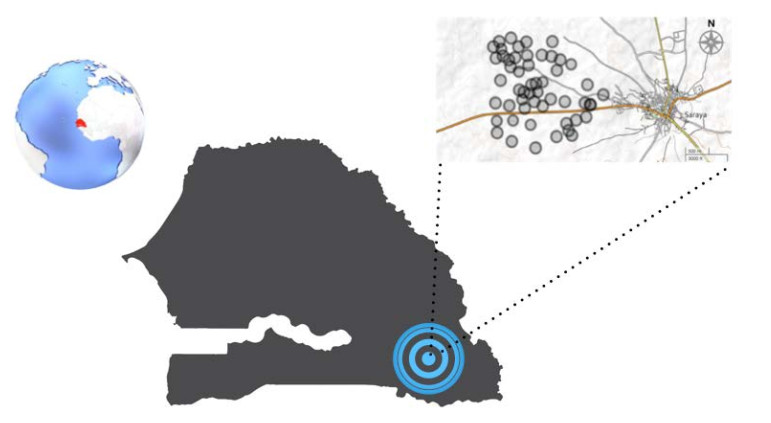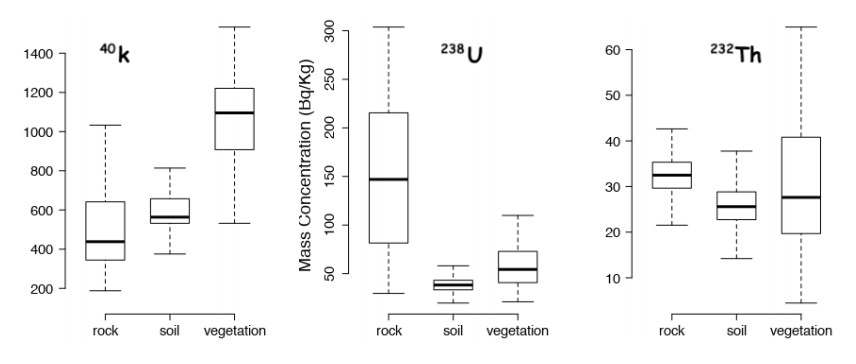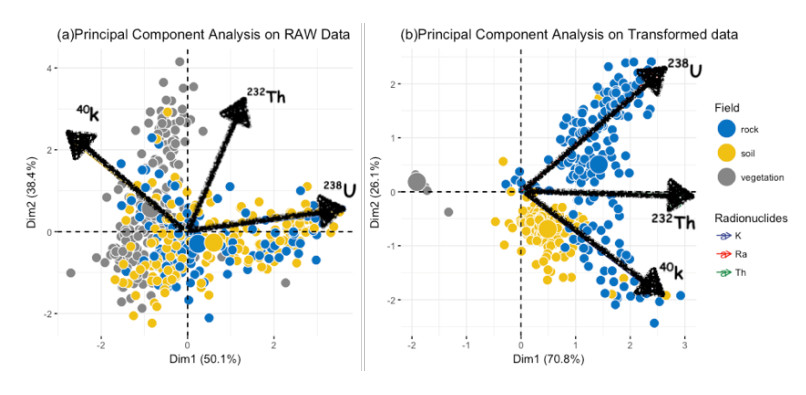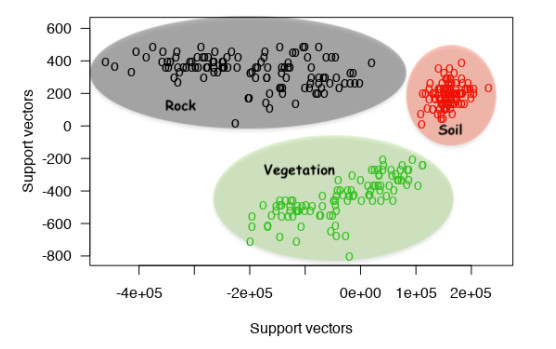A survey of natural radioactivity has been carried out to estimate the concentration of naturally occurring radionuclides and radiological risk associated in the south East mining region, which present high natural background radiation. An in-situ gamma-ray spectrometer was used to map natural environmental gamma-emitting radionuclides. A combined inferential statistical and chemometrics of naturally occurring radionuclides were used for data modelling and characterization. The radiological data surveys were explored using inferential statistical, principal component analysis and a supervised support vector machine learning. First, one-way Analysis of variance, on-parametric Kruskal Wallis test, was applied allowing pairwise comparison of radionuclides levels in sampling sites, second, data was submitted to PCA to extract noise-free data and reduced data was analyzed with support vector machine. PCA results show that 238U contribution (56%) is dominant in the first principal component with 40K (35%). The second component, with the cumulative variance explained of 88%, is dominated by 232Th (68%) and 40K (31%). Anova indicates that there is a significant difference in the mean mass concentration of samples type and soil activities are mostly lower. The best classification accuracy was 100% with the use of radial kernel density function. As potential uranium and gold mine site, these results will allow establishing both reference values for background radiation of the region and fingerprinting sources of naturally occurring radionuclides.
1.
Introduction
In mathematical modelling, the term diffusion is used to describe the motion of species from one region to another. Influenced by various natural factors, such as geographic, hydrological or climatic conditions and human activities, migrations occur between patches, which affects the population dynamics, for example the persistence and extinction of species [1,2,3,4,5,6,7,8]. The growth of species population is also affected by competition caused by disputing food, resources, territories and spouses, including intraspecific and interspecific competitions among populations. To see the effects of the diffusion and competition on population dynamics, we propose the following mathematical model with n species, for i,j=1,2,…,n,
where xi(t) is the population size at time t of the ith species, positive constants ri, aii are the growth rate and the interspecific competition rate of the ith species respectively, aij>0(j≠i) is the competition rate between species i and j, Dij≥0 is the diffusion coefficient from species j to species i, αij≥0 indicates the diffusion boundary condition.
Recently, time delays have been widely used in biological and ecological models in order to get more realistic mathematical models, for example [9,10,11,12,13,14,15,16]. In this paper, we also consider the time delay, which is accounted for the diffusion. For example, birds cannot migrate immediately after they were born, so the time delay here is the time it takes for them to learn to fly before they can migrate, and death can also occur in the process. Then, from (1) we have the model with time delays as follows
where τij≥0 is the time delay and dj is the death rate of the jth species. Let τ=maxi,j=1,…,n{τij} and C([−τ,0];Rn+) denote the family of all bounded and continuous functions from [−τ,0] to Rn+. We assume model (2) is subject to the following initial condition
Reference [17] suggests that the growth rate of organisms is generally affected by environmental fluctuations accounted for the disturbance of ecological environment in nature, consequently parameters in biologic models will exhibit random perturbations [18]. Thus, the deterministic models, like (2) are not applicable to capture the essential characters. In the past years, researchers have suggested the use of white noises to capture the main characters of these stochastic fluctuations, see [18,19,20,21,22,23,24,25,26,27] for example. Denote by {Bi(t)}t≥0,(i=1,2,…,n) the independent standard Brownian motions defined on a complete probability space (Ω,{Ft}t∈R+,P) with σ2i represents the intensity of the environment noises. Then, the growth rate subject to random perturbation can be described by
with which the model (2) reads
We further consider the optimal harvesting problem of model (4). The research on the optimal harvesting of the population is of great significance to the utilization and development of resources, and can also help mankind to get the optimal strategy of harvesting in order to obtain the most long-term benefits [28,29,30,31,32,33,34,35]. Then, we reach the following model accounted for harvesting:
where hi≥0 denotes the harvesting effort of the species i.
In the rest of the paper, we will devote ourselves to explore the dynamics and the optimal harvesting strategy of model (5). More precisely, in Section 2, we establish necessary conditions for persistence of species in mean and extinction of the species. In Section 3, we investigate conditions of stability, and prove asymptotic stability in distribution of the model, namely, there is a unique probability measure ρ(⋅) such that for each ϕ∈C([−τ,0];Rn+), the transition probability p(t,ϕ,⋅) of x(t) converges weekly to ρ(⋅) when t→∞. In Section 4, by the use of the Hessian matrix and theorems of optimal harvesting due to [36], we investigate the optimal harvesting effort and gain the maximum of expectation of sustainable yield (ESY). In Section 5, we numerically illustrate our theoretical results obtained in previous sections, and then conclude our study in Section 6.
2.
Persistence and extinction
For the convenience of the following discussion, we define some notations as follows
and assume that ∑nj=1,j≠iaij≥∑nj=1,j≠iDije−djτij holds in the rest of the paper.
Following the same argument as in [37], we can prove the existence of the positive solution.
Lemma 2.1. Given initial value (3), model (5) admits a unique global positive solution x(t)=(x1(t),…,xn(t))T almost surely. Furthermore, for each p>1, there exists a positive constant K=K(p) such that
To show our main result of this section, we consider the following auxiliary equations
with initial value
By [38,Stochastic Comparison Theorem], we know that for t≥−τ,
Remark 1. It is easy to see from [39] that the explicit solution of (7) is
Similar calculation gives
Then, by using [40], we obtain the following.
Lemma 2.2. Let bi>0. Then, from (7) we have
Based on Lemma 2, we assume:
Assumption 2.1. bi>0,ci>0,i=1,2,…,n.
Remark 2. A result due to Golpalsamy [10] and Assumption 2.1 imply that there exists a unique positive solution (det(A1)/det(A),…,det(An)/det(A))T for the following system
in which
and A_{i} is the matrix given by using the (b_{1}, b_{2}, \ldots, b_{n})^{T} to replace the i th column of matrix A .
Now we are in the position to show our main results.
Theorem 2.1. All species in system (5) are persistent in mean a.s. , i.e. ,
when Assumption 2.1 is satisfied.
Proof. Let b_{i}>0 , according to (12) that for i, j = 1, 2, \ldots, n, \;j\neq i , one has
which together with (9) yields
By using Itô's formula to (5), one can see that
According to (16) together with the property of Brownian motion, we obtain
We next to show that
In view of (9) and (12), we have
Therefore we obtain
From (15) and (12), we get
By using \lim_{t\rightarrow+\infty}t^{-1}B_{i}(t) = 0 together with what we have just obtained, yields that for any given \varepsilon>0 , there exists a T = T(\omega) thus for t\geq T, \;i, j = 1, 2\ldots, n, \;i\neq j,
Applying these inequalities to (11), we have
in which M_{ij}>0 is a constant. Note that c_{i} = b_{i}-\sum_{j = 1, j\neq i}^{n}\frac{a_{ij}}{q_{ji}}b_{j}>0 , thereby for large enough t , one has that
Hence for sufficiently large t , we obtain
Rearranging this inequality shows that
Since t is large enough and \varepsilon is arbitrary, we get (14). This completes the proof of Theorem 2.1.
Corollary 2.1. If there is a b_{i}<0 , then according to (17), one has \limsup_{t\rightarrow+\infty}t^{-1}\ln x_{i}(t)\leq b_{i}<0, \;a.s. It is to say \lim_{t\rightarrow+\infty}x_{i}(t) = 0, \;a.s. , which means that the i th species in system (5) will die out.
3.
Stability in distribution
In this section, we study the stability of the model. To this end, we suppose the following holds:
Assumption 3.1. a_{ii}+\sum_{j = 1, j\neq i}^{n}D_{ij}\alpha_{ij}\geq \sum_{j = 1, j\neq i}^{n}a_{ji}+\sum_{j = 1, j\neq i}^{n}D_{ji}e^{-d_{i}\tau_{ji}}, \;i = 1, 2, \ldots, n.
Then, we can prove the following.
Theorem 3.1. The system (5) is asymptotically stable in distribution if Assumption 3.1 holds.
Proof. Given two initial values \phi(\theta), \psi(\theta) \in C\left([-\tau, 0];R_{+}^{n}\right) of model (5), the corresponding solutions are x^{\phi}(t) = (x_{1}^{\phi_{1}}(t), \ldots, x_{n}^{\phi_{n}}(t))^{T} and x^{\psi}(t) = (x_{1}^{\psi_{1}}(t), \ldots, x_{n}^{\psi_{n}}(t))^{T} respectively. Let
Applying Itô's formula yields
Therefore
Together with \mathbb{E}(V(t))\geq 0 , one has
Hence we have \mathbb{E}\bigg|x_{i}^{\phi_{i}}(s)-x_{i}^{\psi_{i}}(s)\bigg|\in L^{1}[0, \infty), \;i = 1, 2, \ldots, n. At the same time, by using (5) we obtain that
That is to say \mathbb{E}(x_{i}(t)) is continuously differentiable with respect of t . Computing by (5) leads to
in which K>0 is a constant. It implies that \mathbb{E}(x_{i}(t)) is uniformly continuous. Using [41], we get
Denote p(t, \phi, {\rm d} y) as the transition probability density of the process x(t) and P(t, \phi, A) represents the probability of event x(t)\in A . By (6) and [42,Chebyshev's inequality], we can obtain that the family of p(t, \phi, {\rm d} y) is tight. Now define \Gamma\left(C\left([-\tau, 0];R^n_+\right)\right) as the probability measures on C\left([-\tau, 0];R^n_+\right) . For arbitrary two measures P_1, P_2\in \Gamma , we define the metric
where
Since \{p(t, \phi, {\rm d} y)\} is tight, then according to (19) we know that for any \varepsilon>0 , there is a T>0 satisfies that for t\geq T, s>0 ,
Therefore \{p(t, \xi, \cdot)\} is Cauchy in \Gamma with metric d_\mathbb{L} , in which \xi\in C\left([-\tau, 0];R^n_+\right) is arbitrary given. Hence there exists a unique \kappa(\cdot)\in \Gamma(C([-\tau, 0];R^n_+)) such that \lim\limits_{t\rightarrow\infty}d_\mathbb{L}(p(t, \xi, \cdot), \kappa(\cdot)) = 0 . At the same time, it follows from (19) that
Consequently,
This completes the proof of Theorem 3.1.
4.
Optimal harvesting
In this section, we consider the optimal harvesting problem of system (5). Our purpose is to find the optimal harvesting effort H^{*} = (h_{1}^{*}, \ldots, h_{n}^{*}) such that:
(ⅰ) Y(H) = \lim_{t\rightarrow+\infty}\sum_{i = 1}^{n}\mathbb{E}(h_{i}x_{i}(t)) is maximum;
(ⅱ) Every x_{i}(i = 1, 2, \ldots, n) is persistent in the mean.
Before we give our main results, we define
in which G = (r_{1}-0.5\sigma_{1}^{2}, r_{2}-0.5\sigma_{2}^{2}, \ldots, r_{n}-0.5\sigma_{n}^{2})^{T} and I is the unit matrix, and make an assumption:
Assumption 4.1. A^{-1}+(A^{-1})^{T} is positive definite,
Theorem 4.1. Suppose Assumptions 3.1 and 4.1 hold, and If these following inequalities
are satisfied. Then, for system (5) the optimal harvesting effort is
and the maximum of ESY is
Proof. Denote W = \{H = (h_{1}, \ldots, h_{n})^{T}\in R^{n}\mid b_{i}>0, \;c_{i}>0, \;h_{i}>0, \;i = 1, \ldots, n\} . Easily we can see that for any H\in W , (14) is satisfied. Note that \Theta\in W , then W is not empty. According to (14), we have that for every H\in W ,
Applying Theorem 4.1, there is a unique invariant measure \rho(\cdot) for model (5). By [43,Corollary 3.4.3], we obtain that \rho(\cdot) is strong mixing. Meanwhile, it is ergodic according to [43,Theorem 3.2.6]. It means
Let \mu(x) represent the stationary probability density of system (5), then we have
Since the invariant measure of model (9) is unique, one has
In other words,
Assume that \Theta = (\theta_{1}, \theta_{2}, \ldots, \theta_{n})^{T} is the solution of the following equation
Thus, \Theta = [A(A^{-1})^\mathrm{T}+I]^{-1}G . By using of the Hessian matrix (see [44,45]),
is negative defined, then \Theta is the unique extreme point of Y(H) . That is to say, if \Theta\in W and under the condition of (21), the optimal harvesting effort is H^* = \Theta and Y^* is the maximum value of ESY. This completes the proof of Theorem 4.1.
5.
Numerical simulations
To see our analytical results more clearly, we shall give some numerical simulations in this section. Without loss of generality, we consider the following system
which is the case when n = 2 in (5), with initial value
where r_{i}>0, \;a_{ij}>0, \;\tau_{i}\geq 0, \;i, j = 1, 2 .
Firstly, we discuss the persistence in mean of x_{1} and x_{2} . For that, we take the parameter values as follows:
The initial values are x_{1}(\theta) = 0.5+0.01\sin\theta , x_{2}(\theta) = 0.5+0.02\sin\theta , \theta\in[-\tau, 0] . Simple calculations show that b_{1} = 0.7988>0, \;b_{2} = 0.7488>0, \;c_{1} = 0.6662>0, \;c_{2} = 0.6556>0 implying Assumption 2.1 is satisfied. Then by Theorem 2.1, we can obtain that in (29)
Applying the Milstein numerical method in [47], we then obtained the numerical solution of system (29), see Figure 1. It shows that x_{1} and x_{2} respectively asymptotical approach to 0.2268 and 0.5964 time averagely. And this agrees well with our results in Theorem 2.1. Then we research the distributions of x_{1} and x_{2} under the same conditions. Obviously, we have a_{11}+D_{12}\alpha_{12}\geq a_{21}+D_{21}e^{-d_{1}\tau_{21}}, \;a_{22}+D_{21}\alpha_{21}\geq a_{12}+D_{12}e^{-d_{2}\tau_{12}} , it is to say Assumption 3.1 is satisfied. Thus by Theorem 3.1, system (29) is asymptotically stable in distribution as suggested by Figure 2.
Lastly, we consider the optimal harvesting strategy of system (29). It is easy to see that the Assumption 2.1 and Assumption 3.1 are satisfied. Furthermore, we have
in which I = \left( \begin{array}{cc} 1 & 0 \\ 0 & 1 \end{array} \right) . Since condition (21) is satisfied, by Theorem 4.1, the optimal harvesting effort is
on the other hand, the maximum of ESY is
By using the Monte Carlo method (see [48]) and the parameters in Table 1, we can obtain Figure 3, showing our results in Theorem 4.1.
Next, we consider a case of three species.
We use the following parameter values:
The initial values are x_{1}(\theta) = 0.5+0.01\sin\theta , x_{2}(\theta) = 0.5+0.02\sin\theta , x_{3}(\theta) = 0.5+0.001\sin\theta , \theta\in[-\tau, 0] . Easily we get that b_{1} = 0.1.5536>0, \;b_{2} = 0.7881>0, \;b_{3} = 0.2681>0, \;c_{1} = 1.4502>0, \;c_{2} = 0.0552>0, \;c_{3} = 0.0229>0. Thus Assumption 2.1 is hold. By Theorem 2.1, we have for (30)
The numerical results of Theorem 2.1 when n = 3 are shown in Figure 4.
The stable distribution for n = 3 are shown in Figure 5.
To numerical illustrate the optimal harvesting effort of (30), we set
which yield H^{*} = \Theta = (1.1052, 0.5537, 0.1663)^{T} , and the maximum of ESY is Y^{*} = 0.2263 , see Figure-6.
6.
Conclusions and discussions
In this paper, a stochastic n-species competitive model with delayed diffusions and harvesting has been considered. We studied the persistence in mean of every population, which is biologically significant because it shows that all populations can coexist in the community. Since the model (5) does not have a positive equilibrium point and its solution can not approach a positive value, we considered its asymptotically stable distribution. By using ergodic method, we obtained the optimal harvesting policy and the maximum harvesting yield of system (5). We have also done some numerical simulations of the situations for n = 2 and n = 3 in model (5) to illustrate our theoretical results as it is very useful whether in terms of mathematics or biology to visualize our conclusions.
Our studies showed some interesting results
(a) Both environmental disturbance and diffused time delay can effect the persistence and optimal harvesting effort of system (5)..
(b) Environmental noises have no effect on asymptotic stability in distribution of system (5), but the time delays have.
There are other meaningful aspects that can be studied further since our paper only consider the effects of white noises on population growth rate. In future, for example, we can consider the situation when white noises also have influences over harvesting (see [45]) and non-autonomous system (see [46]); the time delay will also be reflected in competition (see [49]). Furthermore, we can consider something more complex models such as the ones with regime-switching (see [50,51]) or Lévy jumps (see [14,42]).
Acknowledgments
This work was supported by the Research Fund for the Taishan Scholar Project of Shandong Province of China, and the SDUST Research Fund (2014TDJH102).
Conflict of interest
The authors declare that there is no conflict of interest regarding the publication of this paper.









 DownLoad:
DownLoad:
